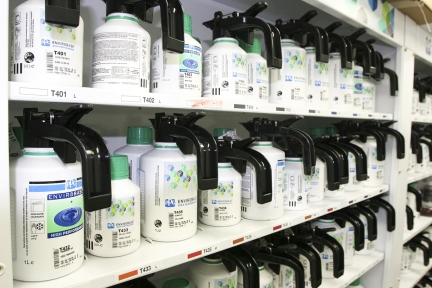
Air emissions
State permits
Facilities that use less than 1,000 gallons of coatings and cleaners per year may qualify as an insignificant facility, which does not need a permit.
Facilities that use less than 2,000 gallons of coatings and cleaners per year may qualify to operate without an air permit if they follow certain requirements.
All others should use this emissions calculator to determine potential and actual emissions from painting and determine if you need an air permit:
Federal permits
The Paint Stripping and Miscellaneous Surface Coating Operations (6H) NESHAP affects facilities that spray paint onto metal, wood, or plastic or use methylene chloride to remove paint.
Halogenated solvent cleaning (T) NESHAP affects facilities that use methylene chloride, perchloroethylene (PCE or perc), trichloroethylene (TCE), 1,1,1- trichloroethane (TCA), carbon tetrachloride, or chloroform for cleaning.
Additional federal air standards for using solvents or surface coating are based on the product you are making, such as appliances, automobiles and trucks, boats, ships, furniture, printing and publishing, or building products.
Air regulation due dates
| Requirement | Due date |
|---|---|
| Emission inventory fee for previous reporting year | Mailed to permit holders between February and March, due within 30 days |
| Emission inventory report | April 1 |
| Emissions summary review period | Begins in August/September |
| Due 180 days after startup |
Hazardous waste
You need a hazardous waste identification number if your business produces any amount of hazardous waste.
Businesses generating most types of hazardous waste are required to report annually, pay a fee, and obtain a license for the subsequent year. Facilities in Anoka, Carver, Dakota, Hennepin, Ramsey, Scott, or Washington County are licensed and inspected by their county. Facilities in greater Minnesota are licensed and inspected by the MPCA. If you produce only small amounts of hazardous waste, you probably qualify as a very small quality generator:
Annual hazardous waste training is required for businesses that generate 220 pounds or more of hazardous waste a month. See the hazardous waste identification and management page for information on managing specific hazardous wastes, such as paint booth filters, solvents, and towels and wipes.
Hazardous waste due dates
| Requirement | Due date |
|---|---|
| Hazardous waste generators fee | Mailed to license holders in first quarter, due date on invoice |
| License application | Due August 15 for Greater Minnesota businesses; Twin Cities metro businesses, contact your county |
Beyond compliance
- Keep painters and paint booth floors, lights, and filters clean to minimize flaws and reduce unnecessary rework.
- Have your painters attend refresher training annually — technique affects transfer efficiency, and that impacts your bottom line. Many painters only achieve about 50% transfer efficiency, meaning half of all the paint you buy is being wasted.
- Replace spray guns, cleaning equipment, etc., with equipment that has better transfer efficiency (e.g., HVLP or electrostatic spray guns). Less overspray means less waste.
- Consider switching to waterborne paints. There are fewer emissions, reduced worker exposure, and a potential reduction in regulatory requirements.
- Minnesota Technical Assistance Program (MnTAP) is a free and confidential outreach program at the University of Minnesota that helps Minnesota businesses develop and implement industry-tailored solutions that prevent pollution, maximize efficient use of resources, and reduce energy use and costs to improve public health and the environment.
- PaintCare offers drop-off sites across Minnesota for recycling unwanted paint for households, businesses, government agencies, and other organizations.
- Paints and Coatings Resource Center (PCRC) provides regulatory and pollution prevention information for painting and coating businesses. PCRC is a valuable resource for those seeking foundational knowledge.